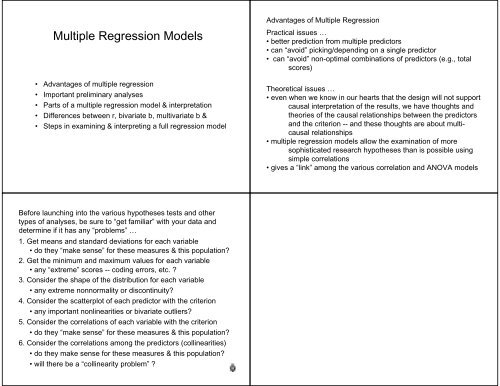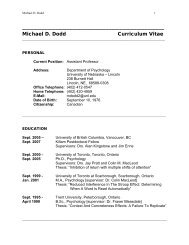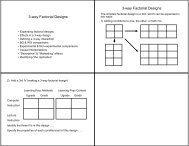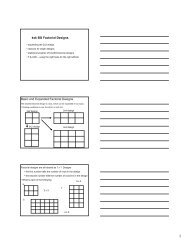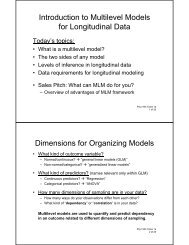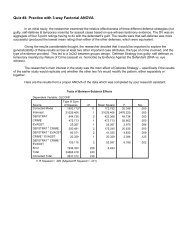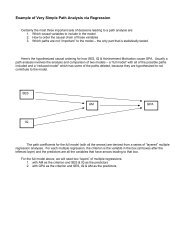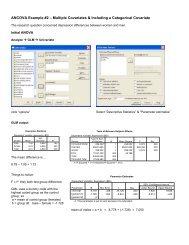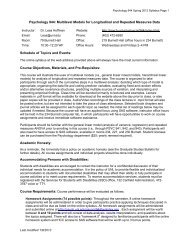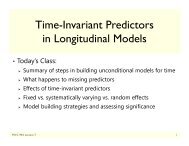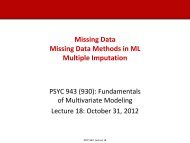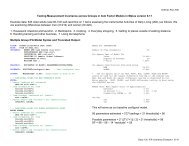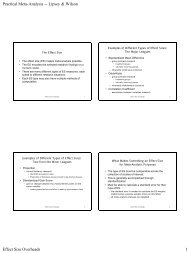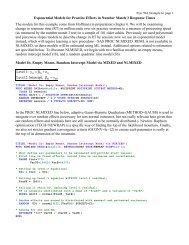Multiple Regression Models
Multiple Regression Models
Multiple Regression Models
Create successful ePaper yourself
Turn your PDF publications into a flip-book with our unique Google optimized e-Paper software.
<strong>Multiple</strong> <strong>Regression</strong> <strong>Models</strong>• Advantages of multiple regression• Important preliminary analyses• Parts of a multiple regression model & interpretation• Differences between r, bivariate b, multivariate b &• Steps in examining & interpreting a full regression modelAdvantages of <strong>Multiple</strong> <strong>Regression</strong>Practical issues …• better prediction from multiple predictors• can “avoid” picking/depending on a single predictor• can “avoid” non-optimal combinations of predictors (e.g., totalscores)Theoretical issues …• even when we know in our hearts that the design will not supportcausal interpretation of the results, we have thoughts andtheories of the causal relationships between the predictorsand the criterion -- and these thoughts are about multicausalrelationships• multiple regression models allow the examination of moresophisticated research hypotheses than is possible usingsimple correlations• gives a “link” among the various correlation and ANOVA modelsBefore launching into the various hypotheses tests and othertypes of analyses, be sure to “get familiar” with your data anddetermine if it has any “problems” …1. Get means and standard deviations for each variable• do they “make sense” for these measures & this population?2. Get the minimum and maximum values for each variable• any “extreme” scores -- coding errors, etc. ?3. Consider the shape of the distribution for each variable• any extreme nonnormality or discontinuity?4. Consider the scatterplot of each predictor with the criterion• any important nonlinearities or bivariate outliers?5. Consider the correlations of each variable with the criterion• do they “make sense” for these measures & this population?6. Consider the correlations among the predictors (collinearities)• do they make sense for these measures & this population?• will there be a “collinearity problem” ?
aw score regressiony’ = b 1 x 1 + b 2 x 2 + b 3 x 3 + aeach b• represents the unique and independent contribution of thatpredictor to the model• for a quantitative predictor tells the expected direction andamount of change in the criterion for a 1-unit increase inthat predictor, while holding the value of all the otherpredictors constant• for a binary predictor (with unit coding -- 0,1 or 1,2, etc.), tellsdirection and amount of group mean difference on thecriterion variable, while holding the value of all the otherpredictors constanta• the expected value of the criterion if all predictors have a valueof 0Let’s practice -- Tx (0 = control, 1 = treatment)depression’ = (2.0 * stress) - (1.5 * support) - (3.0 * Tx) + 35• apply the formula patient has stress score of 10, support score of4 and was in the treatment group dep’ =• interpret “b” for stress -- for each 1-unit increase in stress,depression is expected to by , when holdingall other variables constant• interpret “b” for support -- for each 1-unit increase in support,depression is expected to by , when holding allother variables constant• interpret “b” for tx – those in the Tx group are expected to havea mean depression score that is than the controlgroup, when holding all other variables constant• interpret “a” -- if a person has a score of “0” on all predictors,their depression is expected to bestandard score regression Z y ’= βZ x1 + βZ x2 + βZ x3each β• for a quantitative predictor the expected Z-score change in thecriterion for a 1-Z-unit increase in that predictor, holding thevalues of all the other predictors constant• for a binary predictor, tells size/direction of group meandifference on criterion variable in Z-units, holdingall other variable values constantAs for the standardized bivariate regression model there is no “a”or “constant” because the mean of Zy’ always = Zy = 0The most common reason to refer to standardized weights iswhen you (or the reader) is unfamiliar with the scale of thecriterion. A second reason is to promote comparability of therelative contribution of the various predictors (but see theimportant caveat to this discussed below!!!).
Other versions of the regression equation…using b 0 as constant y’ = b 0 + b 1 x 1 + b 2 x 2 + b 3 x 3y = y’ + error y = b 1 x 1 + b 2 x 2 + b 3 x 3 + a + ecombining these y = b 0 + b 1 x 1 + b 2 x 2 + b 3 x 3 + estandard score version Z y = β 1 Z x1 + β 2 Z x2 + β 3 Z x3 + eIt is important to discriminate among the information obtained from ...bivariate r & bivariate regression model weightsr -- simple correlationtells the direction and strength of the linear relationshipbetween two variables (r = β for bivariate models)r 2 -- squared correlationtells how much of the Y variability is “accounted for,”. “predicted from” or “caused by” X (r = β for bivariate models)b -- raw regression weight from a bivariate modeltells the expected change (direction and amount) in thecriterion for a 1-unit increase in the predictorβ -- standardized regression wt. from a bivariate modeltells the expected change (direction and amount) in thecriterion in Z-score units for a 1-Z-score unit increase in thatpredictorIt is important to discriminate among the information obtained from ...multivariate R & multivariate regression model weightsR 2-- squared multiple correlationtells how much of the Y variability is “accounted for,”. “predicted from” or “caused by” the multiple regression modelR -- multiple correlation (not used that often)tells the strength of the relationship between Y and the. multiple regression modelb i -- raw regression weight from a multivariate modeltells the expected change (direction and amount) in thecriterion for a 1-unit increase in that predictor, holding thevalue of all the other predictors constantβ -- standardized regression wt. from a multivariate modeltells the expected change (direction and amount) in thecriterion in Z-score units for a 1-Z-score unit increase in thatpredictor, holding the value of all the other predictors constant
Venn diagrams representing r, b and R 2Remember R 2 is the total variance shared between the model (allof the predictors) and the criterion (not just the accumulation ofthe parts uniquely attributable to each predictor).R 2 = + + +r y,x1r y,x2r y,x3yx 1x 2x 3x 1x 2x 3yRemember that the b of each predictor represents the part of thatpredictor shared with the criterion that is not shared with any otherpredictor -- the unique contribution of that predictor to the modelb x1 & β x1b x2 & β x2b x3x 1x 2x 3&β x2y
Inspecting and describing the results of a multiple regression formula …0. Carefully check the bivariate results1. Does the model work?<strong>Multiple</strong> -- F-test (ANOVA) of H0: R² = 0 (R=0)( R² ) / kF = ---------------------------------(1 - R²) / (N - k - 1)k = # preds of in the modelN = total number of subjectsFind F-critical using df = k & N-k-12. How well does the model work?• R² is an “effect size estimate” telling the proportion ofvariance of the criterion variable that is accounted for bythe model• adjusted R² is an attempt to correct R² for the inflationpossible when the number if predictors is large relative tothe sample size (gets “mixed reviews” -- replication isbetter!!)3. Which variables contribute to the model ??• t-test of H0: b = 0 for each variable4. Which variables contribute “most” to the model• careful comparison of the predictor’s βs• don’t compare predictor’s bs – more about why later!5. Identify the difference between the “bivariate story” told by thecorrelations and the “multivariate story” told by the multipleregression weights – more later


